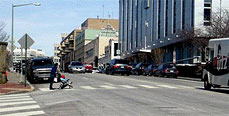Sidewalks, median, and two-way streets among Glover Park recommendations
DDOT is recommending pedestrian improvements, bike lanes, consolidating bus stops, two-way streets, a Wisconsin Avenue median, performance parking and more in their recently-completed Glover Park Transportation Study.
Toole Design Group conducted the study on behalf of DDOT. They conducted a survey of residents, which found that 33% commute by bus compared to 20% by car, and 75% walk to shops along Wisconsin Avenue compared to 25% driving. Here are some of their most important recommendations:
Pedestrian improvements: The study provides recommendations to improve pedestrian safety at various intersections, especially along busy Massachusetts Avenue. They include new graphic “turning vehicles yield to pedestrians” and “stop for pedestrians in crosswalks” signs, leading pedestrian intervals that let people start crossing before turning traffic, new crosswalks near bus stops, and HAWK pedestrian signals.
Sidewalks: The report also recommends completing sidewalks on both sides of every street, starting with parts of Cathedral Avenue, Watson Place, and Fulton Street.
Bike lanes: The report proposes creating new bike lanes on New Mexico Avenue and Tunlaw Road. A bike lane on the northbound side of New Mexico Avenue heading towards American University would let cyclists more comfortably climb the steep hill more slowly than traffic, while southbound cyclists can merge with traffic as they go downhill at comparable speeds.
Another recommendation is creating a new bicycle route from 39th Street to Idaho Avenue and Porter Street. Additionally, the report recommends adding new bike racks along the Wisconsin Avenue commercial corridor and other key locations in Glover Park.
Consolidate bus stops: The study recommends consolidating some duplicate bus stops on Wisconsin Avenue. This could greatly improve the reliability of the 30s buses. It suggests repositioning “the bus stop on the southbound side at the Chevron gas station to the near side of the intersection with Calvert Street. Northbound and southbound bus stops on Wisconsin Avenue between Edmunds Street and Davis Street (adjacent to the Russian Embassy) should then be eliminated.”
Currently, along the 30s line routes, some locations have multiple bus stops on the same block. This reduces the operating speeds of the buses as they have to merge into/out of the curbside lane to pick up passengers. Frequently, the buses also get stuck at traffic lights after picking up just one or two passengers at these redundant stops. Additionally, the merging buses create congestion for other vehicles in the traffic flow, further slowing down other buses along Wisconsin Avenue.
Combining these stops in Glover Park would also result in a higher number of riders at the newly consolidated locations. This would justify improved passenger infrastructure like covered bus shelters at these stops, further encouraging new ridership.
Off-board fare collection: Another important transit recommendation is to work with WMATA to install off-board fare collection equipment at busy bus stops. Such locations include all stops at the Massachusetts/Wisconsin Avenue intersection and all stops within the Glover Park commercial district on Wisconsin Avenue. Cities with successful bus rapid transit have installed ways to pay prior to boarding the bus, improving the operational efficiency of these routes.
Two-way streets: The Glover Park study also recommends converting one-way streets into two-way streets. In more suburban neighborhoods, cul-de-sacs increase vehicle miles traveled and walking distance by prohibiting direct access to major arterial streets. One-way streets create the same issue. Motorists have to drive farther with one-way streets since more direct routes to their destinations are not possible. Additionally, the study notes that the one-way streets in Glover Park create wider lane widths, encouraging people to drive faster than they would with two-way streets and narrower lanes.
Wisconsin Avenue median: Wisconsin Avenue through Glover Park ranges from 55 to 65 feet wide, striped except in the narrowest areas as six lanes with no median. Toole Design studied a number of alternatives for the road, and settled on a configuration adding a median along the entire length, with the median ranging from 6’ without trees to 10-11’ with trees, and 4 travel lanes in most sections with some non-rush-hour parking, some full-time parking, and some center turn lanes.
Performance parking: To strengthen the commercial district, the report suggests a performance parking district for Glover Park. Residential streets would be resident-only (no 2-hour free parking for non-residents) on one side and metered on the other, while commercial streets would be metered on both sides.


